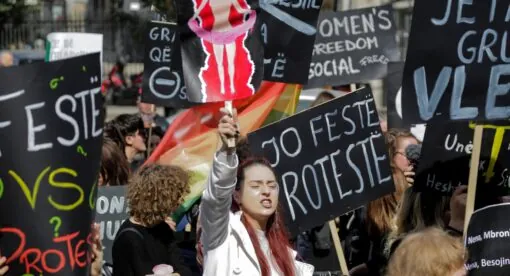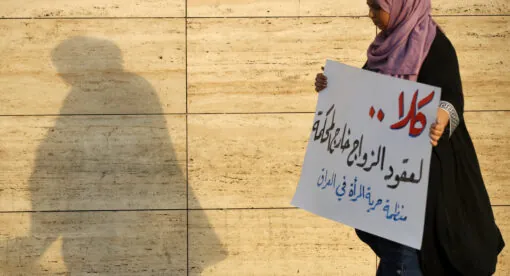The Weekly Forecast Monitor is a forward-looking assessment of geopolitical dynamics shaping our world. To get more in-depth analysis of these issues and learn more about analytical products from New Lines Institute — including simulations, training sessions, and forecast reports — contact us at [email protected] and visit https://newlinesinstitute.org/analytical-products/. Download PDF version.
Global Hotspots
The Global Hotspot Tracker examines the outlook for key geopolitical hotspots around the world. (Go to the Global Connectivity Tracker)
Middle East
Summary – Tensions in the Middle East trended toward a military escalation scenario, as fighting between Israel and Hezbollah continued to intensify and Israel and Hamas continued negotiations over the U.S.-backed cease-fire deal. In Rafah, the Israel Defense Forces continued their offensive westward. In the Red Sea, an attack by al-Houthi fighters caused the abandonment of a Greek-owned vessel.

Military escalation scenario
- Fighting between Israel and Hezbollah continued. Hezbollah carried out multiple attacks, launching hundreds of rockets and 30 suicide drones in retaliation for Israel’s strike on a senior Hezbollah commander.
Risk level – high - Israel rescued four hostages during an operation in Nuseirat that the Gaza Health Ministry said resulted in the deaths of more than 270 Palestinians.
Risk level – high - Israel’s Rafah offensive continued its push westward, raising concerns for the established humanitarian zone in the Al-Mawasi area near the coast.
Risk level – high
Hybrid escalation scenario
- Al-Houthi rebels attacked a Greek-owned vessel in the Red Sea with a missile and small vessel. The vessel began to take on water and is likely to sink. The group also struck multiple vessels in the Gulf of Aden.
Risk level – medium
Diplomatic de-escalation scenario
- Hamas responded to the three phase cease-fire proposal announced by U.S. President Joe Biden with “amendments.” Secretary of State Antony Blinken said some amendments were “unworkable” but that mediators would try to close gaps between the two parties’ demands.
Opportunity level – low
Russia/Ukraine Conflict
Summary – The Russia-Ukraine conflict is trending toward military and hybrid escalation scenarios as the U.S. signed a 10-year security agreement with Ukraine and agreed to transfer additional Patriot missile systems to the country. G7 leaders reached a preliminary agreement to provide $50 billion in financing to Ukraine backed by interest generated by frozen Russian assets. Russia continued to undermine Ukraine’s efforts to solicit support for a June 15-16 peace summit in Switzerland.
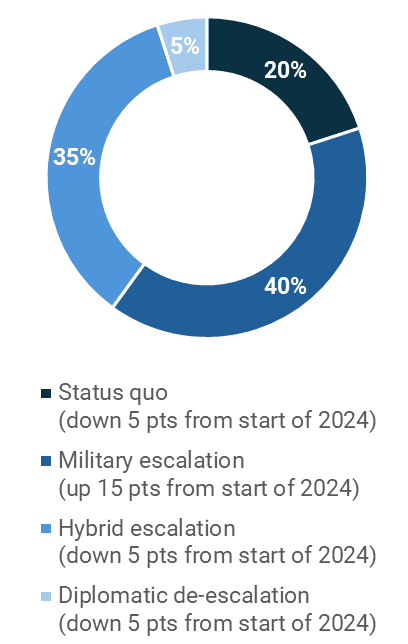
Military escalation scenario
- The U.S. and Ukraine signed a 10-year security agreement during the G7 summit in Italy, which seeks to commit U.S. support for Ukraine beyond the Biden administration.
Risk level – medium - The U.S. and Germany agreed to transfer 100 Patriot air defense systems to Ukraine, while the U.S. lifted a ban on providing weapons to Ukraine’s Azov Brigade.
Risk level – medium - Russia conducted tactical nuclear drills alongside troops from Belarus.
Risk level – low
Hybrid escalation scenario
- A preliminary agreement was reached during the G7 summit that would provide Ukraine with approximately $50 billion in loans backed by profits from frozen Russian sovereign assets.
Risk level – medium - Russian attacks against Ukraine’s energy infrastructure have taken out half the country’s electricity generation and will lead to outages and rolling blackouts this winter if the country doesn’t receive more air defense systems, Ukrainian President Volodymyr Zelenskyy said.
Risk level – medium - The EU is considering sanctioning Russian shipping giant Sovcomflot to restrict government revenues, according to Bloomberg.
Risk level – low
Diplomatic de-escalation scenario
- Russian Foreign Minister Sergei Lavrov thanked Chinese Foreign Minister Wang Yi for China’s decision not to participate in a June 15-16 Ukrainian peace summit in Switzerland. At least 90 countries and international organizations are set to participate in the summit.
Opportunity level – low - Russian President Vladimir Putin said Moscow is prepared to order an immediate cease-fire if Ukraine withdraws from the four regions annexed by Russia in 2022 and drops its bid to join NATO.
Opportunity level – low
U.S./China/Indo-Pacific
Summary – Tensions in the Indo-Pacific trended toward a hybrid escalation scenario, as trade tensions between Europe and China increased after the European Commission announced additional tariffs on Chinese electric vehicles (EVs). The U.S. imposed additional secondary sanctions to counter Russia’s war in Ukraine, targeting Chinese and Hong Konger companies. Tensions on the Korean Peninsula continued to increase as South Korea resumed propaganda broadcasts along the border, and North Korean soldiers crossed the military demarcation line.
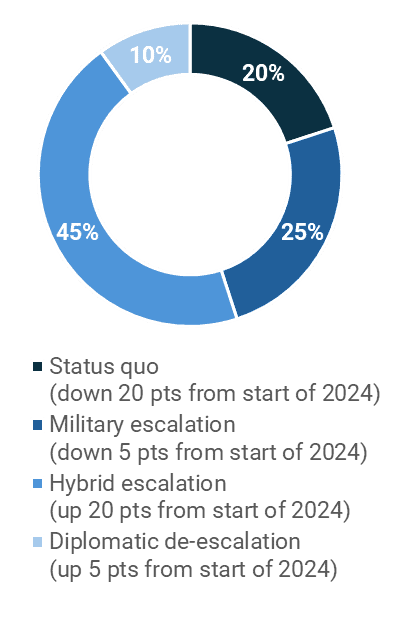
Military escalation scenario
- South Korean soldiers fired warning shots after North Korean soldiers briefly crossed the military demarcation line.
Risk level – medium - China said it confronted a Dutch naval frigate in the East China Sea after a Dutch helicopter “intruded east of Shanghai.” The Dutch navy accused China of “unsafe maneuvers.”
Risk level – medium - China carried out military training in the South China Sea, deploying three Type 055 guided-missile destroyers. Three advanced destroyers participating in the same training has been rare for China.
Risk level – low - Taiwan will hold its annual Han Kuang military exercise in July and will involve Kinmen County, a Taiwan-controlled island six miles from Xiamen, China.
Risk level – low - Philippine National Security Adviser Eduardo Año said the country will continue its resupply missions in the South China Sea.
Risk level – low
Hybrid escalation scenario
- The European Commission announced additional tariffs (up to 38.1% for a total of 48.1%) on Chinese EVs starting in July. European dairy and pork farmers are concerned about potential retaliatory Chinese tariffs after reports that Chinese companies are preparing requests for anti-subsidy and anti-dumping investigations into those sectors.
Risk level – medium - The U.S. imposed secondary sanctions, targeting a Chinese company selling semiconductors to Russia and Hong Konger companies assisting a sanctioned Russian miner in trading gold. The U.S. continues to consider additional sanctions on Chinese entities.
Risk level – medium - South Korea resumed delivering anti-North Korea propaganda over loudspeakers along the border.
Risk level – medium
Diplomatic de-escalation scenario
- No major indicators
Global Connectivity
The Global Connectivity Tracker examines the sectoral impact of geopolitical dynamics on key themes like the global energy/climate transition, trade, and technology. (Go to the Global Hotspot Tracker)
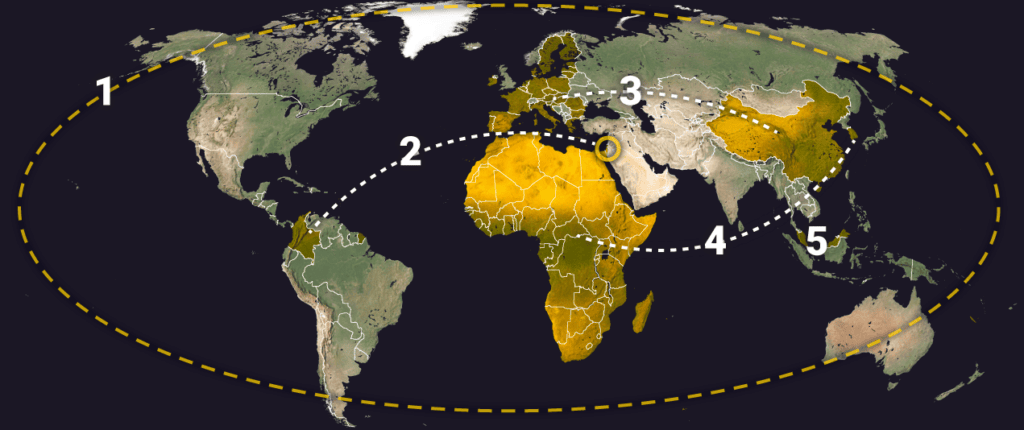
Energy/Climate
- Global: Climate
What happened: The International Energy Agency reported that global investments in clean energy technology and infrastructure in 2024 are expected to reach $2 trillion, twice as much as is being invested in fossil fuels.
Significance/Outlook: Energy investment will reach $3 trillion in 2024, with $2 trillion going toward clean energy technologies and $1 trillion to fossil fuels like oil, gas, and coal. Clean energy technologies include renewables; electric vehicles, nuclear power, smart grids, and energy storage; carbon capture and storage; zero- and low-carbon fuels; efficiency improvements; and heat pumps. In spite of the significant investments made in clean energy technology, this is not enough to achieve net zero emissions by the middle of the century. A recent BloombergNEF report asserts that energy transition investment must average $4.8 trillion per year from 2024 to 2030 to meet the Net Zero Scenario.
Opportunity level – low/medium - Colombia/Israel: Coal
What happened: Colombian President Gustavo Petro declared his country will ban coal exports to Israel over the Gaza war.
Significance/Outlook: Israel, which uses coal generation to supply over 20% of its electricity needs, receives more than 50% of its coal supply from Colombia. Colombia’s move may pressure Israel to rethink its Gaza Strip policy and put pressure on West Bank settlements that use coal-fired electric facilities. Petro said exports will resume if Israel complies with the order from the International Court of Justice to withdraw its forces from Gaza. A similar ban may be implemented by other nations, such as South Africa, which supplies 9% of Israel’s coal.
Risk level – medium - China/EU: Electric Vehicles
What happened: The European Commission said it will impose tariffs of up to 48% on electric vehicle (EV) imports from China starting in July.
Significance/Outlook: European authorities have been concerned about the competitiveness of local manufacturers as a result of the spike in EV exports from China to Europe. Sales of Chinese-made electric vehicles in Europe rose 23% in the first four months of the year despite EU measures to protect local producers. One of the primary reasons that Chinese-made models have been so popular is that the price of new European-produced EVs is much higher. While tariffs would assist local EV manufacturing, EU carmakers can compete with Chinese brands only by increasing mass-market electric vehicle production and investing in the European battery supply chain.
Risk level – medium - South Korea/Africa: Critical Minerals
What happened: South Korea has signed nearly 50 deals with several African countries in the fields of critical minerals, energy, and manufacturing.
Significance/Outlook: Africa accounts for 1-2% of South Korea’s trade and investment, and this new step will enable increased cooperation, especially in energy security. Hyosung Corp., a South Korean conglomerate, has signed a contract valued at $30 million to supply electric transformers to Mozambique. Similar deals were signed with Madagascar and Tanzania to collaborate on critical minerals, aiming to secure supplies for industries like battery manufacturing. The cooperation extends to 23 African countries whose economies need investment, especially in terms of energy accessibility and efficiency. South Korean President Yoon Suk Yeol has also pledged to increase development aid for Africa to $10 billion, along with $14 billion in export financing.
Opportunity level – low/medium - . Malaysia: Energy
What happened: The Malaysian government is eliminating blanket diesel subsidies.
Significance/Outlook: The decision is expected to increase the retail price of diesel fuel by 50% to 3.35 ringgit ($0.71) per liter and will begin aligning with the market prices. This step will generate savings of approximately $853.24 million annually, which will be channeled into public infrastructure, health care, and education to support low-income groups. Despite some concerns among the public, diesel prices in Malaysia will still be among the lowest in Southeast Asia, compared to 8.79 ringgit per liter in Singapore, 4.43 ringgit in Indonesia, and 4.24 ringgit in Thailand.
Opportunity level – low
Key Stats of the Week
- Just under 60% of new electric car registrations in 2023 were in China, 25% in Europe, and 10% in the U.S., accounting for approximately 95% of global electric car sales.
- Chinese vehicle makers’ continuous expansion in 2023 changed the European automotive scene. Total Chinese brand sales in 2023 were 321,918 units, up 79%.
- According to a new survey, 19 percent of electric vehicles sold in Europe in the previous year were manufactured in China.
Source: Oilprice.com



